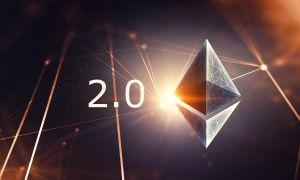What Is Ethereum 2.0?

Source: Adobe Stock.
Everywhere you look nowadays, there is an Ethereum-killer. At times, it seems as if protocol knights pop up monthly in fully-coded armor to slay the cyberspace dragon named Ethereum. Those who believe that Ethereum's reign will come to an endpoint due to Ethereum's high gas fees, low transactions per second, and feature the revolutionary qualities of [insert X] blockchain protocol.
While it is certainly possible that future Ethereum will not be the blockchain of choice for the creation of decentralized applications (dapps), thousands of projects have already been built on the Ethereum blockchain. From the biggest decentralized exchange, Uniswap, to the largest NFT marketplace in OpenSea, Ethereum's community is growing at a rapid pace.
What has many believe the Ethereum project will reach new heights is the much-awaited upgrade Ethereum Serenity, otherwise known as Ethereum 2.0. Set to be released sometime in 2022, it has Ethereum fans hopeful that it will succeed in alleviating all of Ethereum's current woes. The release date in 2022 also has Ethereum aficionados concerned that other blockchain projects will catch up in the meantime.
Only time will tell if Ethereum's first mover advantage will continue its solid position as the second-best cryptocurrency in the world (as measured by market cap). Until then, let's take a brief look at the promises of Ethereum 2.0.
What is Ethereum 2.0?
Ethereum Serenity, or Ethereum 2.0, is not an alternate cryptocurrency. It is best to think of Ethereum 2.0 as an upgrade to the Ethereum network. This upgrade attempts to tackle many key issues of the blockchain, like scalability, usability, and sustainability. Although Ethereum has reached unprecedented levels of market valuation this year, popular projects like Cardano, Zilliqa, Solana, Algorand, and others could potentially threaten Ethereum's position as the second biggest crypto coin if it doesn't solve many of its problems.
Not surprisingly, newer protocols boast of higher transactions per second, better scaling solutions and network fees that won't break the bank. Newer technology often has an advantage over older technology since years of development take place in bolstering blockchains, so upgrades are needed for older tech to keep up. Ethereum is no exception to this.
Usability
Ethereum, in its current non-upgraded state, has been hit with enormous transaction fees, called gas fees. Gas fees are paid in order to provide the energy needed to validate and work out transactions on the Ethereum blockchain. These high fees happen when the network is busy processing tons of transactions. Even making a simple transaction on decentralized applications can be upwards of USD 200 on busy days. To whales who have millions of dollars of ETH to play with on decentralized finance (DeFi) applications, this may seem like child's play. However, to the average person who works a 9-5 job, forking over USD 200 to transfer a cute digital monster NFT in a video game isn't palatable.
This has made it increasingly difficult for average users to partake in Ethereum applications like trading crypto on Uniswap or buying a digital cat on CryptoKitties. The usability of the blockchain would take a hit since the barrier to entry would be too high for the average person to use.
Scalability
Let's imagine that these gas fees are actually low enough for the average crypto user not to bat an eye when making transactions, like a USD 0.25 per transaction instead of 80 times that amount with USD 200. Even with this, Ethereum can only process 15 transactions per second (tps) as of right now. By comparison, Visa does around 1,700 tps, more than a hundred times of Ethereum's non-upgraded version.
Although Ethereum's transaction speed is three times greater than Bitcoin's 5tps, if decentralized applications are going to be commonplace, then they should at least be close to the speed of traditional financial tools like Visa. It's hard to imagine Ethereum to be as scalable as traditional financial institutions when the transaction speed remains small.
Granted, using blockchain technology feels so much faster than going through all those Know-Your-Customer questions and other banking hoops. In crypto, you just input your wallet address, and you'll receive. Even Bitcoin, the oldest cryptocurrency, feels quick to wire without the hoops. Still, once the scalability solutions come about, there will be even more reason to turn to the decentralized world for financial needs.
Sustainability
Proof-of-Work consensus mechanisms have been under attack by media outlets as unsustainable because of environmental impact, even though cryptocurrencies have been proven to not have the large-scale environmental impact the outlets claim. Even so, whatever helps in creating a more sustainable, decentralized ecosystem will be welcome by many. Proof-of-Stake offers this solution by running validator nodes instead of mining. Since immense electrical input is needed to mine blocks in Proof-of-Work, running validator nodes to validate blocks will save tons of energy, making sustainability a reality.
Serenity, or Ethereum 2.0, if successful, will have the usability, scalability and sustainability to operate for users all over the world. This will make DeFi applications like Aave and Compound easier to run. If decentralized financial tools need USD 100 to make a single transaction, not many will believe in decentralized protocols as an alternative to mainstream finance. Also, if it takes that amount to sell a piece of digital property or artwork, one would wonder about the widespread use of it all.
Hopefully, Ethereum 2.0 will put to end all of those concerns and allow its extensive worldwide user base to continue operating smoothly.
Ethereum 2.0 Solutions
Ethereum 2.0 is said to have next-generation blockchain solutions to these problems. The scalability will be solved by using an alternative consensus mechanism or a way in which computers in a network can be in agreement. If computers all over the world are going to be using Ethereum, then they need a way to function together. The current consensus mechanism for Ethereum is Proof-of-Work, which uses mining in order to validate blocks or data sets. These often come with some problems that Proof-of-Stake tries to solve.
How Does Proof-of-Stake Work?
Instead of mining, which requires vast electrical input, Proof-of-Stake uses what are called validator nodes in order to secure the network. Validator nodes are the alternatives to mining, in which users set up a node for a single ETH. These nodes, or computers processing the network, will be picked at random to create blocks. Blocks are the cryptographic files in which data is recorded, a digital ledger in cryptography.
In traditional mining, you need to have incredible resources to effectively mine blocks for Ethereum and other legacy cryptocurrencies. In this way, it heavily favors those with resources. By staking ETH and running validator nodes, all you need is a decent computer with a good CPU or GPU, not a mining rig that costs thousands of dollars. The validator nodes, in turn, have the same chance of a person with a regular rig mining a block and a company with vast resources and multiple nodes. It won't be like in mining, where more computational power will result in a far higher chance of blocks being mined. Every validator node will have the same chance of receiving the same block rewards. Although a company can have a hundred validator nodes, each of those nodes has the same chance of rewards as a regular person's one computer node. This is because the rewards are randomized. The company will have a higher chance of rewards only because they have a hundred of them, not because their rig is more powerful.
The threat of a 51% attack or an attack that controls the network seems more possible. However, there isn't much incentive to do this as it would devalue the network. Imagine that you use a few hundred billion dollars to gain the majority stake and control all of Ethereum. You would probably lose hundreds and hundreds of millions, maybe even a billion if you controlled the network and made the millions of users around the world trust it less.
Firsthand, it does seem that Proof-of-Stake is an overall improvement to Proof-of-Work. This isn't a certainty, however, since the protocol is still in its infancy, which is the main knock against Proof-of-Stake. Time will tell if it will truly usurp Proof-of-Work forever.
The Beacon Chain
The Beacon Chain is how the future Ethereum network will be coordinated and will be the one that introduces Proof-of-Stake into the network. It will set up the shard chains that improve the speed of transactions and make the network larger. The Beacon Chain is the base of a more secure, sustainable, and scalable Ethereum. It will manage old Ethereum, the mainnet, into the Proof-of-Stake system.
The Beacon Chain is Phase 0, so truly the building block of Ethereum 2.0.
The Merge
This is where the main Ethereum network will fuse with Proof-of-Stake using the Beacon chain to create a possibly better Ethereum. Right now, Proof-of-Work still secures the Ethereum network, running in parallel with Proof-of-Stake. The Merge, which sounds like the beginning of an epic movie, is when these will be fully intertwined. Mining will cease as a way to secure the network. And according to Ethereum, this will lead to endless shard chains and˜endless scalability for Ethereum.
Shard Chains
Across 64 chains, the shard chains will expand the network's load and make for an˜endless scalability post-merge, keeping node requirements low. Sharding, in computer science parlance, is a way to split a database horizontally. In Ethereum, this will make the load more manageable for a network, increasing the number of transactions per second and reducing network congestion in these fresh chains or shards. The projected transactions per second (tps) will be 100,000 tps compared to the 10-15 transactions per second of Ethereum now. This is known as Shard Chain Version 1: data availability. Shard Chain Version 2: code execution will give a lot more features to shards, like smart contract execution and account management.
Closing Thoughts
Ethereum is the largest platform for the creation of decentralized applications. After its implementation, DeFi applications like Aave and Compound will be easier to run. If decentralized financial tools need USD 100 to make a single transaction, not many will believe in decentralized protocols as an alternative to mainstream finance. Also, if it takes that amount to sell a piece of digital property or artwork, one would wonder about the widespread use of it all. Ethereum serenity will attempt to cure these problems.
With all the funding and intelligence being put into its continued development, as well as its army of fans and developers, Ethereum will most likely stay relevant in blockchain for years, if not decades, to come. Ethereum Serenity, or Ethereum 2.0, will be the test to see if Ethereum will continue its use-dominance over other protocols. Only time will tell if an Ethereum-killer will finally slay the mystical beast or if Ethereum continues to be the main network of decentralized applications.
